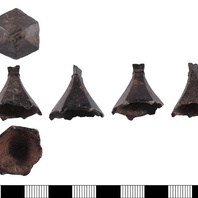
Viking Objects
Norse Bell (LIN-4509A8)
Bells of this type are described as a ‘Norse’ bell because of their association with Scandinavian sites though not much else is known about their purpose or origin. However, it seems likely that they were used as harness decorations.
Read More
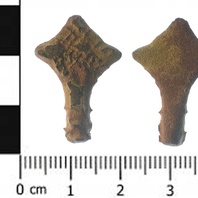
Viking Objects
Kite-Shaped Pin (SWYOR-53AEC4)
This type of kite-shape-headed pin is considered to be of Irish origin and imported through Viking activities.
Read More
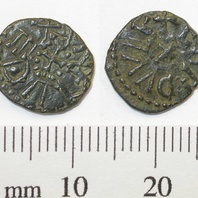
Viking Objects
Northumbrian Styca (DENO-87CE96)
This copper-alloy styca was minted by the moneyer Eardwulf in the name of King Ethelred II of Northumbria during his second reign. While Wessex and Mercia were using silver coinage as part of their monetary economy, Northumbria was using copper coins known as stycas, which may have contained trace amounts of silver. The concentration of these coins at sites such as Torksey and ARSNY suggests that they could have remained in circulation after the fall of Northumbria in 866 but were taken to the sites by the Vikings during their campaigning. they were not much use to the Vikings within their silver-based bullion economy but it is suggested that they were treated as raw material and were used as commodity money instead. The evidence for the production of copper-alloy strap-ends at Torksey and ARSNY supports this idea that the stycas were used for production.
Read More

Viking Objects
Samanid Silver Dirham (NCL-544D22)
A silver Samanid dirham of al-Shash dated possibly to 912 AD. The dirham was a unit of weight used across North Africa, the Middle East, and Persia, with varying values which also referred to the type of coins used in the Middle East during the Viking Age. These coins were extremely prized possessions not only for their silver value but as a way of displaying one’s wealth and vast trade connections. Millions of Arabic Dirhams would have been imported throughout the Viking world and are mostly found in hoards. Arabic dirhams demonstrate contact between the Viking diaspora and the Arabic world. Arabic coins are especially useful for dating sites, because they carry the date when they were minted. This permits precise dating where the part of the coin with the date survives, whereas European coins can only be dated to the reign of the ruler depicted on them. In western descriptions of these coins, the Arabic dates found on the coins are usually listed in square brackets, as above, and the European equivalent is listed after it.
Read More
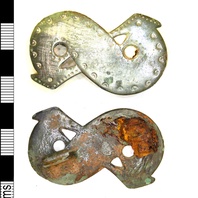
Viking Objects
Frankish Zoomorphic Brooch (LEIC-06202B)
The design of this brooch suggests that it was of Frankish manufacture and dates to roughly 600-700 AD. It is possible that it made its way to England prior to Viking incursions but it is equally likely that the Vikings brought this brooch with them as plunder after raiding in Frankia. For more information on Scandinavian jewellery in England check out our blog: Brooches, Pendants and Pins: Scandinavian Dress Accessories in England.
Read More
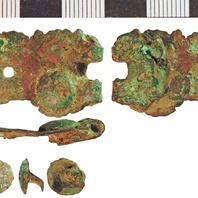
Viking Objects
Frankish Trefoil Buckle (NLM-60D592)
This cast copper-alloy buckle plate is trefoil in form and has traces of gilding which appear on the display side. The use of tripled domed rivets is similar to Frankish buckle styles introduced from the seventh century, while the use of gilding may relate this to eighth-century styles. It is possible that it made its way to England prior to Viking incursions but it is equally likely that the Vikings brought this buckle with them as plunder after raiding in Frankia.
Read More
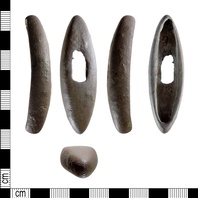
Viking Objects
Sword Hilt or Top Guard (DENO-87124F)
A copper-alloy hilt or top guard from an early medieval, possibly Viking, sword or dagger.
Read More
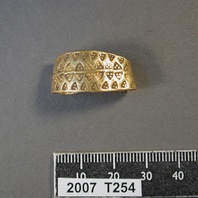
Viking Objects
Gold Stamped Finger Ring (DENO-9A6C17)
A gold finger ring decorated with two rows of interlocking stamped triangles with triple pellets in each. The stamped decoration is typical of Viking jewellery of the late 9th-10th centuries and a punch-decorated gold ring of broadly similar form has been found at Thetford.
Read More
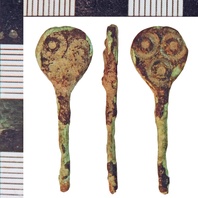
Viking Objects
Ring-and-Dot Pin (NLM-7A2D15)
Copper-alloy cast pin with a flat discoid head, no collar, and stamped decoration on the head, Flixborough type 601. The head bears three large [diameter 4.4mm] ring-and-dot motifs on each of its opposed faces. The tip of the shank is lost. The introduction of flat-headed pins with ring-and-dot decoration, superseding other types, is held by Dave Haldenby to mark the arrival of Viking settlers at Cottam, East Riding of Yorkshire. Suggested date: Early Medieval, 865-925. The finder suggests this to be part of an assemblage amounting to c.5% of material recovered from an extensive site, the rest being removed illicitly without record. Archaeological opinion holds the site to have been of equivalent character to Flixborough, North Lincolnshire, in terms of its material culture. Coins are under-represented in the group.
Read More
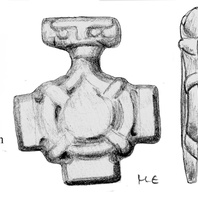
Viking Objects
Die Stamp (NLM-690F57)
This cast copper-alloy die was used in the process of making filigree pendants of the Hiddensee-Rügen type, more specifically, to create pressed silver or gold sheet appliqués, which were applied to a pendant back-plate and used as a base for filigree and granulation work. The ring in the centre creates a closed ring-knot motif related to the Scandinavian Borre style. The Hiddensee-Rügen style is named after the gold jewellery hoard discovered in the late nineteenth century on the island of Hiddensee, off the Baltic coast of Germany. The Swinhope die is one of a small group of recorded objects used in the production of Hiddensee-style cruciform pendants. No finished pendants of the type represented by the Swinhope die are known, either from England or Scandinavia.
Read More
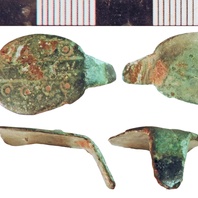
Viking Objects
Copper-Alloy Finger-Ring (NLM-D4A8C9)
A copper-alloy cast finger-ring featuring circular punched ring and dot decoration. Ring and dot was a decorative technique used at various periods from the later Iron Age onwards, but which enjoyed a Viking Age revival.
